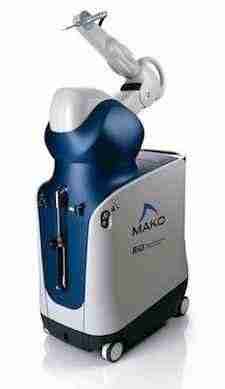
With advancements in the medical field and the robotics field, it only makes sense that the two would merge, and that is a prime example of what robotic knee surgery is. The merging of science and technology with medicine to help eradicate common problems and ailments, such as knee injuries associated with osteoarthritis.
Please allow us to take a moment to clear up some misconceptions about this type of surgery while informing you of some its benefits, as well as the finer points of our MAKOplasty and RIO software system, which is looking to change the way people look at, and address, knee injuries.
What Is It?
Though robotic knee replacement can sound scary and intimidating, we are here to assure you it is not. It is a surgery for people suffering from early to mid-set osteoarthritis, and it only focuses on the area of the knee that is diseased, as opposed to having to get work done on the entire knee, which can carry with it more risks. MAKOplasty partial knee resurfacing is surgery performed with the RIO Robotic Arm Interactive Orthopedic Systems, which is a rather remarkable piece of machinery, and as intimidating as that may seem, we are here to assure you it is nothing short of remarkable, and nothing to be intimated by.
This is a revolution, and we are on the front lines.

Fine Points About MAKOplasty Partial Knee Surfacing
Partial knee replacement can be a complicated and delicate procedure, and this is where the MAKOplasty machine comes in. Robotic knee surgery is redefining how procedures are done in the field, and this is due to the success rate, as well as the machine’s ability to perform very delicate tasks with lightning-like-precision.
The robotic arm assisted Makoplasty ensures consistently accurate results, with precision implant placement, which is essential with the implant taking, and also maximizes the potential life of the implant, which many doctors can tell you, is one of the main problems with having the procedure done the old fashioned way. If the implant is even a millimeter off, it will set wrong, and it will be rendered obsolete faster. With our MAKOplasty partial knee surfacing, that is no longer an issue.
It should also be noted that a study was held of over 200 patients that received MAKOplasty assisted surgery, and they reported less pain in the 8 weeks following the surgery, when compared to those using OXFORD implants, which is what has been used in these sorts of procedures up to this point.And patients who received RESTORIS MCK medial onlay implants showed a much lower failure rate than those who went with the manual surgery.
We are in a field where results speak louder than anything else, and that is what we are presenting now; results.
How Does It Work?
There are multiple factors that make MAKOplasty so much more advanced than other knee surgeries. First off, a full CT scan is taken of the patients knee using RIO’s system software to figure out exactly what entails the knee injury. The pre-surgical plan is developed using this exact model of the knee, ensuring individualized attention where it is needed for each patient. This cuts costs and all but renders mistakes associated with this kind of delicate surgery obsolete.
What is even more remarkable about this step is that doctors can go in and fine tune the positioning of the knee and soft tissues while using this software, and any changes that may be encountered during the surgery can be accounted for BEFORE the surgery begins, which is a huge step in nullifying any of the problems normally associated with manual surgery. This is what sets robotic knee surgery apart from all other surgeries.
The details of the surgery and the particular knee injury are then programmed into the RIO software system, which helps to create a “safety zone” for the bone removal. What most seem confused about regarding this type of surgery is the fear that a machine has the room to make an error, and how would anyone know? And that leads us to our next point.
Misconceptions About Robotic Knee Surgery
The most essential thing people need to know about MAKOplasty and robotic surgeries is that it is still very much the doctor who is in control of the surgery. It is the doctor CONTROLLING the robotic arm, but the RIO ensures the bone removal stays within the “safety zones”, providing constant aural and visual feedback about the procedure directly to the doctor as it happens. That is what really sets robotic surgeries apart, especially when dealing with the knee and osteoarthritis. It is still very much a human touch, but with some computer assistance to simply cut down risks and up the success rate of the surgery, which is exactly what MAKOplasty has accomplished so far.
MAKOplasty is typically covered by Medicare and approved and private health insurers,which makes it much more accessible to anyone looking to improve their quality of life.
In Closing….
Partial Knee Replacement is a serious procedure, with some serious risks, and with MAKOplasty robotic knee surgery, we pride ourselves on slowly minimizing those risks, one by one, all while upping the long term success rate of such procedures. We are here to help you get your life back, and get it back to the quality you were once accustomed to.
No one should be forced to suffer or endure pain or limited activity day after day and there is no one else changing the way knee surgeries and robotic surgeries are looked at quite like Dr. Steven Struhl.
Contact Dr. Struhl today to find out how MAKOplasty can help you get back to your life!



